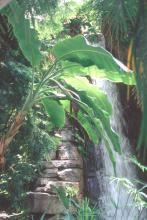Information Possibly Outdated
The information presented on this page was originally released on August 12, 2002. It may not be outdated, but please search our site for more current information. If you plan to quote or reference this information in a publication, please check with the Extension specialist or author before proceeding.
Japanese fiber banana is a cold-hardy species
By Norman Winter
MSU Horticulturist
Central Mississippi Research & Extension Center
When I say you need some fiber, I'm not talking about bran flakes for breakfast. If you love tropical plants as much as I do, you have got to try the Japanese fiber banana in your landscape.
Even though it is a tropical, gardeners on the Tennessee border can grow this cold-hardy banana species. The plant is known botanically as Musa basjoo. The banana gets about 10 feet tall and adds great interest to the landscape.
Its cold hardiness makes it possible to grow bananas throughout the South, allowing gardens to look like the West Indies. Though it may be hard to believe, well-mulched Japanese fiber bananas have been known to return from minus 20 degrees.
The flowers are among the most beautiful and exotic, but don't start counting on a harvest -- these bananas aren't edible.
Most gardeners and garden centers do not know about the Japanese fiber banana yet, but I predict they will soon. I bought mine at a garden center in north Mississippi. You might ask your garden center to get some for you. If they seem willing but can't locate a source, have them give me a buzz. Otherwise, you can buy your own through mail order.
Plant the Japanese fiber banana in the spring after the soil has warmed and threats of freezing weather has past. Full sun and fertile, well-drained, organic-rich soil is needed for both vigor and cold hardiness. Amend the soil if needed with 3 to 4 inches of compost or humus and till to a depth of 8 to 10 inches.
For beds with bananas, add three pounds of a slow release 2-1-2 or 2-1-3 fertilizer per 100 square feet of bed space. Sometimes these formulas are hard to find. If you can't find this ratio fertilizer, use three pounds of a 12-6-6. Plant the banana at the same depth it is growing in the container.
Bananas are heavy feeders and need light, monthly applications of fertilizer and plenty of moisture. Keep them well mulched. Trim leaves as needed to keep them attractive. Once the foliage has been frosted in the fall, trim and add an extra layer of mulch. Despite the cold hardiness of the Japanese fiber banana, soggy winter soil places a spring return in jeopardy.
You will notice that Japanese fiber banana plants produce suckers. Divide these suckers to place in other garden locations or you can give some to me.
Use the Japanese fiber banana to add coarse-textured foliage to the perennial or cottage garden, transforming it into the look of the islands. Plant them around swimming pools, water gardens, and next to the deck, porch or patio. Grow with other tropicals like elephant ears, hibiscus and allamandas.
The Japanese fiber banana is sold generically and usually comes with a tag that says Musa basjoo or basjoo. Look also for the yellow Chinese wax banana Musella lasciocarpa, which is cold hardy throughout zone 7. The bright yellow bloom on this one will make you want to invite the neighbors over for a party.



